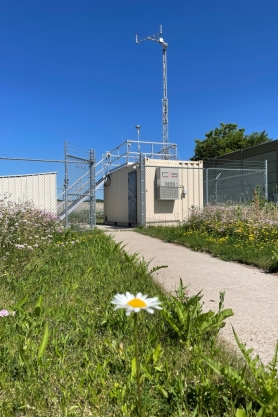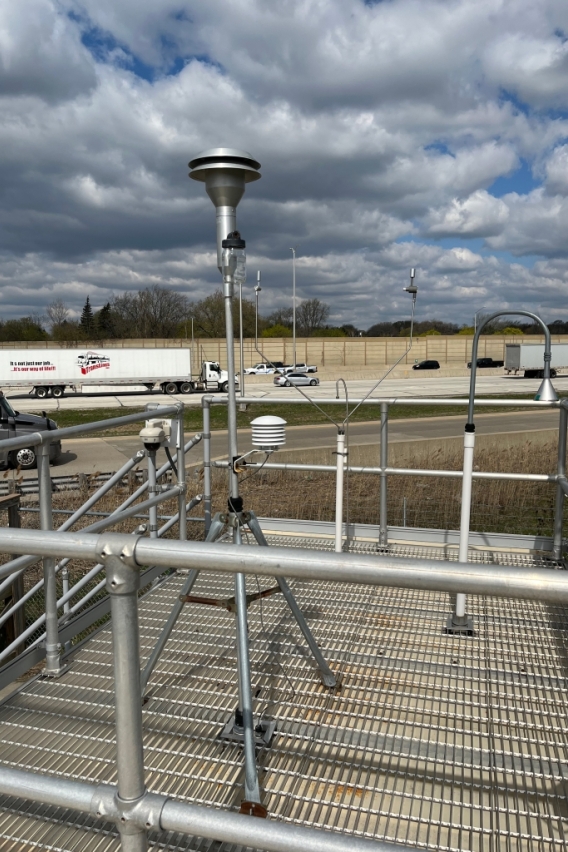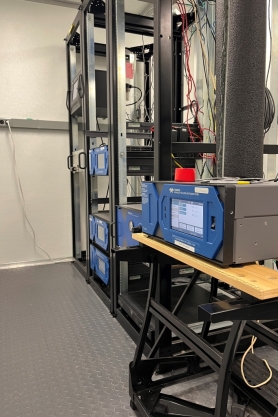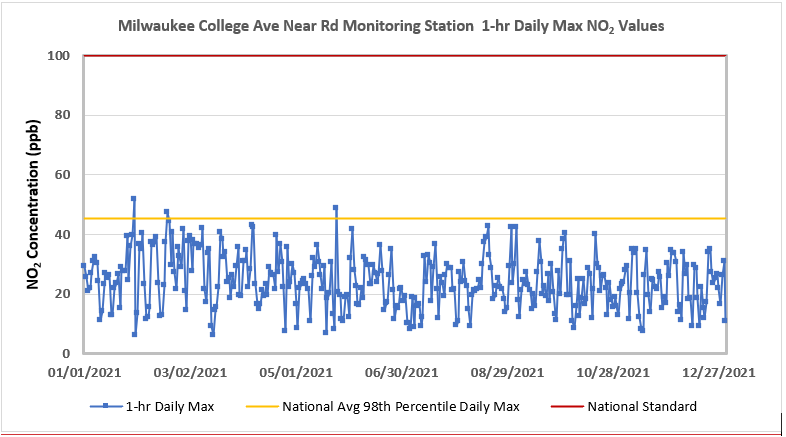Air Quality Monitoring
Wisconsin's ambient air quality monitoring network is spatially distributed as outlined by the Clean Air Act to provide timely access to air quality information, support planning for air quality improvements and verify program adequacy. The network focuses on EPA's list of the most serious health-related air pollutants: ozone, particle pollution, sulfur dioxide, nitrogen dioxide and carbon monoxide. Using continuous monitoring data, DNR quickly informs the public when air pollution reaches unhealthy levels. Based on this information, people may adjust their daily activities to minimize adverse health effects.
The monitoring network uses federally approved methods for measuring air quality and is reviewed annually, through a network plan requirement that encourages public participation.
To see how Wisconsin's air quality compares with the rest of the nation, check out U.S. EPA AIRNOW.
Sensors
Air quality sensors
The air sensor technology market is expanding as more companies make lower-cost portable sensors available to the public. The information outlined below provides the public with best practices for the use of low-cost, portable air sensors and may be used to assist citizens with the setup of low-cost sensors, evaluation of the data collected and the interpretation of the results.
Resources
The EPA provides a comprehensive toolbox of low-cost, portable sensor information.
- Air Sensor Toolbox for Citizen Scientists, Researchers and Developers
- Air Sensor Performance Testing Protocols, Metrics, and Target Values for PM2.5 and Ozone EPA Webinar
- EPA Air Sensor Guidebook
The South Coast Air Quality Management District (AQMD) established the Air Quality Sensor Performance Evaluation Center (AQ-SPEC) program to provide guidance and inform the public about the performance of low-cost air sensors.
The DNR assembled a road map for setting up an air monitoring project and instructions on setting up a Purple Air Sensor.
One commonly used low-cost sensor is manufactured by PurpleAir. Comparability studies found that the data associated with the PurpleAir sensors can compare more accurately with federal reference method samplers by applying a predetermined, local correction factor. There are three correction factors currently available on the PurpleAir website. The U.S. EPA correction factor offers the most applicable broad scale conversion factor currently available on the website.
The DNR conducted a study to develop a correction factor for PurpleAir Sensors with a goal of improving the accuracy and utility of these sensors for citizens in Wisconsin interested in local air quality.
The Wisconsin PurpleAir correction factor is:
Pac = PA * 0.5140 +1.8304
PAc is the corrected value for that day.
PA is the daily PurpleAir particulate concentration.
For further details on the PurpleAir comparison study and correction factors see the Wisconsin DNR PurpleAir Study Summary.
DNR PurpleAir Collocated Study and Documentation
Other Sensor Studies
Network Review
Network Review
Annual Review
The DNR periodically reviews its air monitoring network and provides an opportunity for public input on monitoring locations and pollutants to be monitored.
- Draft 2026 Air Monitoring Network Plan
- 2026 Air Monitoring Network Plan-Response to Public Comments
- Final 2025 Air Monitoring Network Plan
- 2025 Air Monitoring Network Plan-Response to Public Comments
- U.S. EPA Approval of the 2025 Network Plan
Five-year network assessment
Every five years, states are required to perform a more extensive assessment of its network to ensure the best possible use of available resources to meet policy, regulatory and technical needs. Wisconsin DNR staff cooperated with representatives from the states of Illinois, Indiana, Michigan, Minnesota and Ohio, local agencies, as well as U.S. EPA and the Lake Michigan Air Directors Consortium to develop a Five-Year Network Assessment that provides a broader, more comprehensive evaluation of the monitoring within the region. The regional assessment has been updated to include design value rank, population served, area served, correlation between sites and site removal bias. The results of these analyses are offered in both graphical and tabular formats. Further, a review of sites eligible for shutdown and an analysis of revenue and operation costs are provided. This assessment is intended to provide information on whether monitoring networks still meet the monitoring objectives, whether new sites are needed, whether existing sites are no longer needed and whether new technologies are appropriate.
Based on federal monitoring requirements and data analyses, the document provides detailed conclusions broadly consisting of key findings, new priorities and important issues including the recurring concern of sufficient funding. Although the recommendations are non-binding, Wisconsin's air monitoring program uses this as a tool for prioritizing monitoring operations and budgeting in upcoming annual network assessments.
Ambient air monitoring network configuration and siting criteria
The EPA sets minimum network requirements in federal code. Monitoring beyond federal minimum requirements is conducted to provide better documentation of air quality in a particular community. For example, adequately defining the ambient ozone problem in any given area, especially the larger urban areas, generally requires additional monitors. Federal grants fund the majority of the DNR air monitoring network.
Operating within funding constraints, Wisconsin's air program continues to:
- consolidate monitoring sites;
- increase automation;
- eliminate redundancies;
- upgrade to higher-sensitivity monitors for reactive nitrogen and carbon monoxide; and
- enhance the air toxics monitoring network.
We continue to work toward expanding network coverage in Wisconsin through partnerships with industry, Native American tribes and other entities.
Near-Road Network
U.S. Environmental Protection Agency (EPA) near-road monitor program
Motor vehicle exhaust in urban areas affects concentrations of various pollutants in ambient air. To better understand this impact, the EPA developed the Near-Road Monitoring Network as part of the 2010 review of the nitrogen dioxide (NO2) National Ambient Air Quality Standards (NAAQS). This network requires state and local air monitoring agencies to operate near-road NO2 monitoring stations at locations where peak hourly NO2 concentrations are expected to occur. The Core Based Statistical Area (CBSA) of the Milwaukee metropolitan area met criteria to have a near-road monitoring station installed.
Near-road monitor establishment
As required, from May 2012 to December 2013, the DNR considered and tested several locations in and around the Milwaukee CBSA. Based on traffic volumes and preliminary analysis, the current College Avenue location was selected and Wisconsin began operating its near-road monitoring station on Jan. 1, 2014. The station is located in Milwaukee County near the College Avenue exit off of Interstate Highway 94.
Pollutants measured
The EPA sets the National Ambient Air Quality Standards (NAAQS)for certain pollutants known as criteria pollutants. The near-road site currently measures three criteria pollutants and tests for numerous additional non-criteria pollutants utilizing Special Purpose Monitors (SPMs).
The near-road site measures NO2, carbon monoxide (CO) and fine particles (PM2.5) as required by the EPA. Supplementary measurements of wind direction, wind speed and temperature are also collected to support analysis of the pollution measurements. All measurement equipment is connected to an on-site data logger where monitoring data are collected and transmitted continuously to the DNR's central data system. Consistent with other monitoring stations, real time data are made available through the DNR WebMap and EPA's AirNow webpage.
Criteria pollutants
Nitrogen dioxide is one of a group of highly reactive gases known as "oxides of nitrogen" (NOx). The EPA's NAAQS uses NO2 as the indicator for the larger group of nitrogen oxides. Nitrogen dioxide forms quickly from emissions from cars, trucks and buses, power plants, and off-road equipment. In addition to contributing to the formation of ground-level ozone and fine particle pollution, NO2 is linked with a number of adverse effects on the respiratory system.
Carbon monoxide is a colorless, odorless gas emitted from combustion processes. Nationally, and particularly in urban areas, most CO emissions in ambient air comes from mobile sources. Carbon monoxide can cause harmful health effects by reducing oxygen delivery to the body's organs. At extremely high levels, CO can cause death.
Fine particles are comprised of particles that are 2.5 micrometers and smaller in diameter. These particles form as a result of chemical reactions of precursors such as sulfur dioxide (SO2), NOx, organic carbon and ammonia. Fine particles are considered an inhalable particle pollutant that can have adverse health effects on the respiratory and circulatory systems.
Current hourly values of NO2, CO, and PM2.5 from the Near Road site can be viewed using the interactive Air Quality Monitoring Data map.
Special Purpose Monitors
The DNR also operates several Special Purpose Monitors (SPMs) at the near-road site. These SPMs measure black carbon (BC) [exit DNR], a by-product of combustion that may include diesel emissions, as well as ultraviolet-absorbing particulate matter (UVPM). These data are used by the EPA to better assess the health impacts of the near-road environment.
Nitrogen Dioxide and Carbon Monoxide - Wisconsin near-road and national trends
Since its establishment in 2014, the Wisconsin near-road monitoring site has not measured an exceedance of the NO2 or CO NAAQS. The maximum reported individual one-hour NO2 reading so far has been 62.8 parts per billion (ppb), well below EPA's national one-hour standard of 100 ppb.
National data from 2019-2021 (NO2) and 2020-2021 (CO) indicate that Wisconsin and other states with a near-road air monitoring station are below the NAAQS 1-hr standards for NO2 and CO. This means that across the nation near-road sites are reporting NO2 and CO values well below the NAAQS.
Industrial Monitoring
Industrial monitoring
The DNR provides support and technical expertise to facilities that are required to do ambient air monitoring as part of a permit condition. Air monitoring staff review ambient air monitoring plans (AAMPs) and monthly data reports. They also conduct data consolidation/archival audits as well as annual instrument audits.
A large portion of the current industrial monitoring network in Wisconsin is related to industrial sand mines. Additional information can be found on our sand mining web pages.
Guidance documents and tools
The links below include information and guidance regarding DNR audit procedures for high volume samplers. Additionally, industrial operators will find information about operation of samplers (calibrations, verifications and routine operations). Forms are provided to use as-is, or to modify and use to suit an industrial operator's needs.




